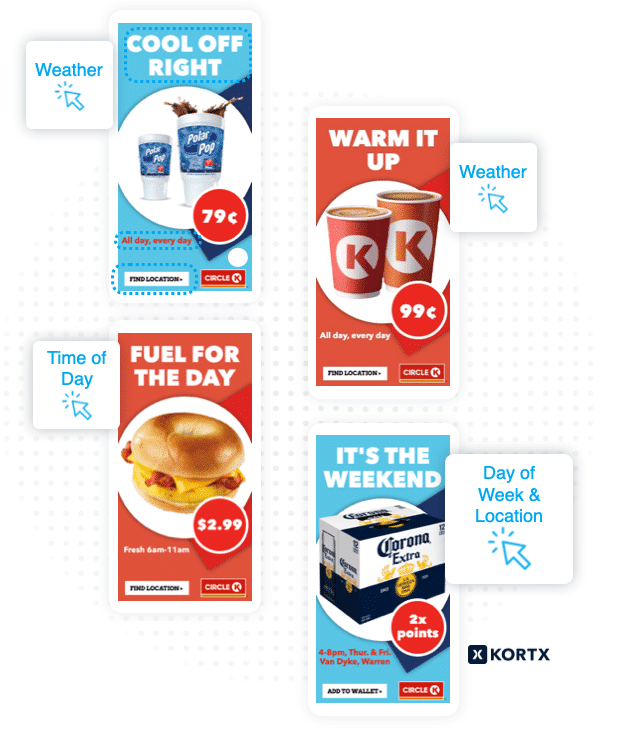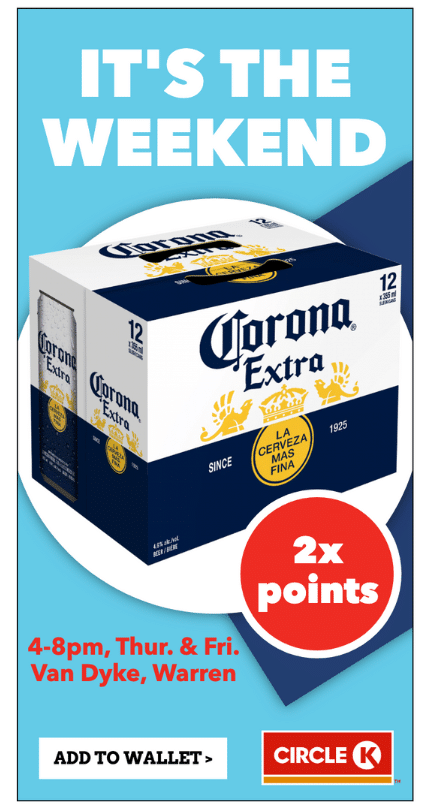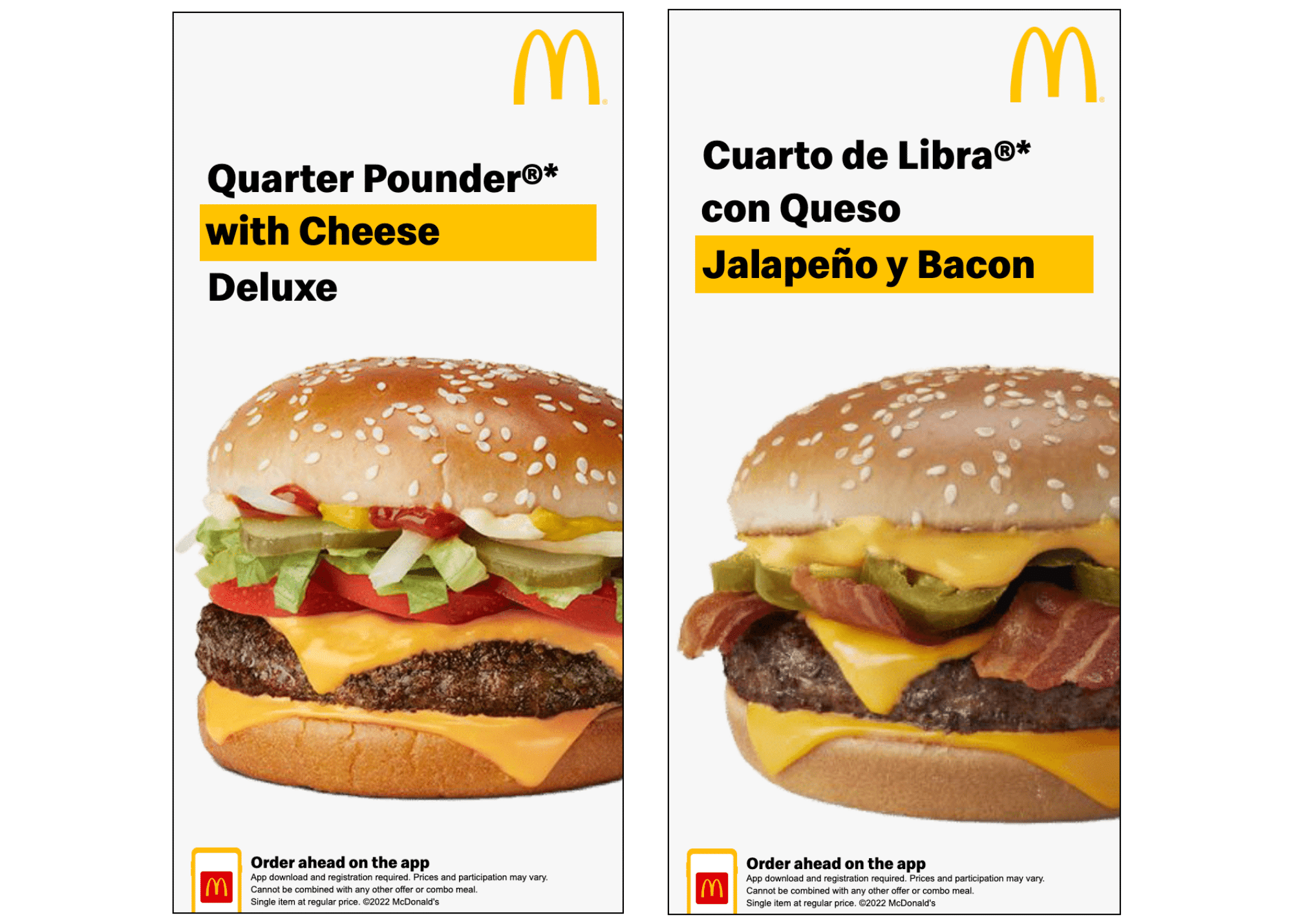The era of generic, one-size-fits-all ads is over. Today’s consumers crave personalization and delight in unexpected creativity. Luckily, marketing campaigns can now tailor their approach in real-time, adapting to individual user behaviors, contexts, and preferences for a more engaging experience.
Learn how Dynamic Creative Optimization (DCO) can make your advertisements timely, efficient, and incredibly personalized.
What is Dynamic Creative Optimization (DCO)?
Dynamic Creative Optimization (DCO) uses algorithms to analyze user data like demographics and browsing habits in real time, automatically adjusting ads to show the most relevant version to each user.
DCO ads resonate with potential customers, aligning with their immediate context and needs.
Example: Circle K Dynamic Convenience Store Example

In this Circle K example, notice how each ad adapts to specific triggers: weather conditions, time of day, and even the day of the week combined with location. The ad recommends a refreshing drink for a hot day and suggests a warm beverage to cozy up with on a cold day.
Dynamic Creative Optimization enables the adaptation of these ad types:
- Rich Media: Uses advanced features like video, audio, and interactive elements to engage users more deeply than standard ads.
- Display: Static or minimally animated banner ads placed on websites to promote brand awareness.
- Interactive Video (Pre-Roll): Videos that play before other content and feature interactive options like clickable buttons to engage users.
- CTV & Interactive CTV: Television content delivered over the internet on connected devices, with ads that can include interactive elements such as QR codes or shoppable carousels.
And alters these ad components:
- Images (background or product images): Visuals that enhance an ad’s aesthetic appeal and relevance, including background scenery or featured product shots.
- Text (headlines, body copy, & calls to action (CTAs)): The written content in an ad, including attention-grabbing headlines.
- Colors (CTAs, background shapes): Attract attention, evoke emotions, and influence consumer behavior, especially through CTAs and background design elements.
- Video: A dynamic format that combines visuals, sound, and movement to tell a compelling story or showcase a product.
- Landing Page: A web page that serves as a website visitor’s initial point of contact or arrival.
- Font: The design and style of textual characters used in an ad.
What About Ad Triggers?
Ad triggers are specific conditions or user behaviors, such as location, weather, or browsing history, that prompt the dynamic display of tailored advertising content.
Examples of dynamic triggers include:
- Time (time of day, day of week, and date)
- Location
- Browser language
- Weather (precipitation, temperature, or wind)
- Precipitation: Sunny, Cloudy, Rain, snow, hail, or fog
- Temperature: Cold, hot, mild, or custom (custom = minimum and maximum degrees set)
- Wind: Windy or No wind
📚 Related article: 9 CTV Ad Examples to Inspire and Wow You
Get inspired by successful CTV ad examples and learn how to create compelling creative in the digital age.
Why is Dynamic Creative Optimization Important?
Consumer attention is a coveted currency. DCO captures and retains attention by delivering personalized ads and experiences.
Here’s why it’s essential:
- Personalization at Scale: DCO uses data insights to customize ads to individual preferences. Mass advertising feels one-on-one.
- Enhanced Engagement: Tailored ads resonate more deeply with viewers, leading to higher engagement rates and optimized ad spend.
- Conversion Optimization: DCO-driven ads reflect users’ interests and behaviors, making them more likely to convert interest into action.
- Brand Loyalty: Personalized experiences foster a positive brand connection, turning occasional buyers into loyal customers.
- Efficiency & ROI: DCO utilizes only the highest-performing creative.
- Market Agility: Brands can quickly adjust to trends and changes in consumer behavior, keeping campaigns effective and relevant.
- Adaptability in a Post-Cookie World: With Third-Party cookie deprecation, DCO’s ability to use First-Party data and contextual signals means messaging remains relevant.
How to Get Started with a DCO Campaign
A well-executed DCO strategy builds strong connections with your audience by showing the right message at the right time.
Launching a campaign requires a clear roadmap and a few things before getting started:
1. Discover Your Audience
Use market research and analytics tools to understand your target audience’s demographic and behavioral characteristics, including age, gender, occupation, and interests.
Segment the audience based on behavior metrics such as page visits and ad interactions, and map customer journeys to identify critical touchpoints. This process helps gather insights for personalized ad customization, ensuring relevance and engagement for each audience segment.
With this foundational audience discovery, every ad impression is optimized for engagement and impact, even before your campaign officially launches. Audience data helps you to unlock intricate details about your customers’ preferences and behaviors, allowing for highly targeted and personalized ad experiences.
2. Set Up Your Goals & Parameters
Collaborate with your team to define the framework of your DCO campaign. Outline all the conditions (like time of day or user activity), values (such as specific product interests), and locations (geographic targeting) that will influence how your ads are served.
3. Prepare Your Assets
The assets needed for a DCO campaign are similar to those used in traditional advertising. You’ll need a variety of creative elements (images, headlines, body text) that can be mixed and matched based on the campaign’s rules.
However, the key difference lies in the preparation of these assets. Assets should be designed to be flexibly combined in a variety of ways. Maintaining an open layout facilitates messaging adjustments while preserving the integrity of the design components.
4. Watch the Automation Work
Once your campaign parameters are set, the DCO platform takes over. It utilizes algorithms to analyze incoming real-time data and adjusts ads accordingly.
This “automagic” process guarantees your ads stay optimized for relevance and engagement, minimizing the need for manual adjustments.
🎨▶️ See how we can transform your ads from ordinary to extraordinary with our creative solutions.
Examples of Dynamic Creative Optimization (DCO) Ads
DCO supports diverse campaign strategies, including geographic targeting, interest-based variations, contextual web page customization, and product-focused ads that account for audience viewing history.
Let’s look at a few examples of how we use dynamic creative optimization.
1. Time of Day

Time-of-day ads use dynamic content to align QSR menu items with the right time of day. They feature breakfast until 10:30 AM, lunch until 4 PM, and dinner options afterward.
Use Cases:
- QSRs & Fast-Food Restaurants: Aligning digital ads with daily menu availability.
- Retail Stores: Promoting flash sales with quick, limited-time offers.
- Automotive Industry: Digital Out-of-Home banners promoting service deals during morning commutes.
📚 Related article: 5 Exceptional Fast Food & QSR Ad Examples
Discover how top brands cook up irresistible fast-food ads that inspire customers’ orders.
2. Day-of-the-Week

Day-of-the-week ads adjust content for retail stores, updating product images, headlines, and prices to match weekly promotions.
Use Cases:
- Retail Stores: Highlighting changing offers and sales, keeping digital ads current with promotions. Can work for any retail industry: furniture and home goods, clothing, beauty, and more.
- Banking & Finance: Offering promotions related to tax prep services, especially as tax deadlines approach in April.
- Healthcare: Promote routine prescription refills and checkups at the start of the week.
3. Milestone Events

Milestone event ads automatically update content using triggers linked to key dates, adjusting for events like sale ends or lottery jackpots.
Use Cases:
- Lotteries: Updating jackpot amounts in real-time as they increase.
- Retail Stores: Counting down to the end of a holiday sale.
- Automotive: Promoting end-of-model-year sales, and updating ad content as the deadline approaches.
📚 Related article: Dynamic Lotto Ads: The Power of Custom Triggers
Find out how custom triggers drive engagement for lotto brands.
4. Location

Location ads deliver custom headlines and images for different areas, suited for highlighting local sales or events like sports games.
Use Cases:
- Real Estate: Announcing open house events in different neighborhoods.
- Sports: Promoting home games by targeting ads to fans within the stadium vicinity.
- Museum: Promoting day trip ads to far away state residents and promoting quick trips to residents within a 10-minute radius.
5. Browser Language

Browser language ads adjust copy to match the user’s browser language, presenting content in the viewer’s familiar language.
Use Cases:
- eCommerce: Promoting local deals, seasonal sales, or relevant sales in the user’s browser language.
- Travel & Tourism: Tailoring ads in different languages to highlight regional travel advice, visa information, and exclusive deals.
- Higher Ed: Promoting programs and admissions information in the prospective student’s native language.
How can brands maintain effective advertising amid changing digital landscapes and targeting?
“Brands buy advertising to drive outcomes, and today’s market demands mastery in creative relevancy and mass personalization. By employing variants and dynamic content, we can tailor messaging and targeting to meet the diverse needs of our audience effectively. This approach not only boosts engagement but also transforms our connection with consumers by delivering highly relevant messaging, tailored to each phase of the buyer’s journey, driven by data and contextual cues.”

6. Weather

Ad content adapts to the weather, switching images and promotions to align with seasonal products. For example, clothing stores transition from sweaters to T-shirts, and coffee shops shift from warm drinks to cold ones.
Use Cases:
- Retail Stores: Using weather triggers to swap ad content from heavy coats and sweaters to light t-shirts and shorts as the local weather warms up.
- QSR & Fast-Food Restaurants: Adjusting ads to feature cold beverages or ice cream on hot days and hot chocolate or warm coffees on cold days.
- Destination-Specific Marketing: Promoting sunny tropical getaways during cold, wintry days in the viewer’s area or cozy mountain retreats with skiing opportunities during regional snowfalls.
Integrating Dynamic Creative Optimization (DCO) & Customer Insights
One final component of Dynamic Creative Optimization (DCO) is incorporating customer-level learnings that inform messaging and enable the delivered creative to present a more personalized user experience.
The Data Feedback Loop
DCO’s success hinges on the “data-in and data-out” principle: the quality of the ad’s success is directly influenced by the quality of the input (customer insights).
- High-Quality Insights: Results in creatives finely tuned to user preferences and behaviors significantly improve engagement.
- Low-Quality Insights: Leads to a mismatch between ad content and user expectations, diminishing user experience and ad performance.
Data-mature companies that successfully gather and utilize First-Party data from multiple sources, such as Customer Relationship Management (CRM) tools, website analytics, and email marketing campaigns, tend to achieve better business outcomes. They see up to 2.5x the improvement in revenues and profits, Net Promoter Score (NPS), lifetime customer value (LCV), and overall operational efficiency compared to less data-focused peers.
Organizations that continuously refine their data collection and analysis processes can enhance the quality of their insights.
Examples of Using Customer Insights in DCO
Explore two examples of how we could use customer insight data for DCO:
1. Personalization Strategies in DCO
Identifying purchase intent within a customer group to tailor promotions.
Tactical Approach: Use research data to confirm potential buying behavior and dynamically insert discounts or rebates during specific sale periods, enhancing the likelihood of conversion.
2. Localization and Timing
Leverage geographic data like zip codes or cities to understand customer purchase recency.
Tactical Approach: Customize ads for specific stores with decreased revenue, potentially boosting sales by aligning the ad content with local demand patterns.
Aligning data quality with creative execution is crucial for maximizing the impact of DCO.
Using DCO for Memorable Customer Connections
Dynamic Creative Optimization (DCO) empowers modern marketers to enhance creative relevance and foster experimentation at scale. Using technology that facilitates seamless messaging and continual optimization, marketers can creatively engage audiences with inspiring and insightful content, forging memorable connections that drive lasting loyalty.
Messages that hit every time.
We specialize in understanding your brand’s unique voice and audience. Every piece of content we produce resonates deeply and drives meaningful engagement.
About the Author
Eric Simone is the lead designer at KORTX. He is a design wizard and a pro at commercial editing, UX, and project management. Eric has made it his mission to deliver eye-catching designs that pack a punch.
